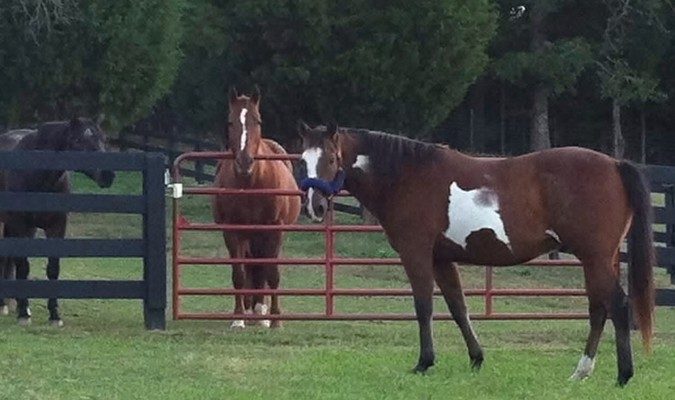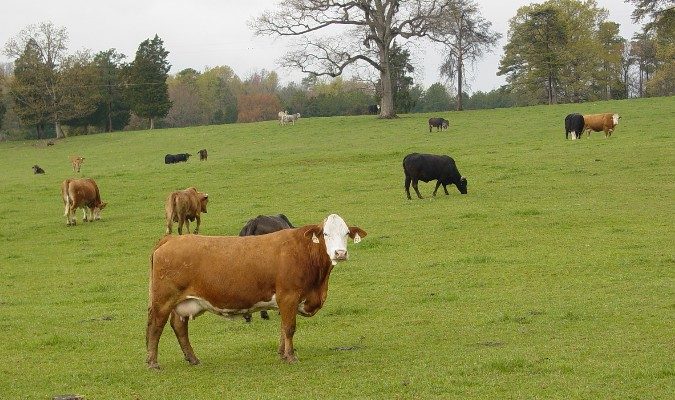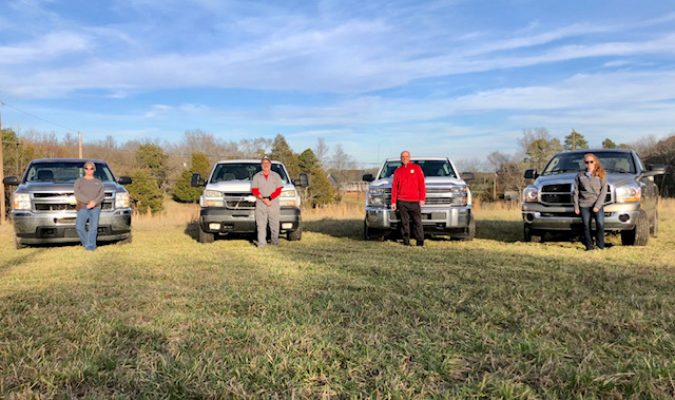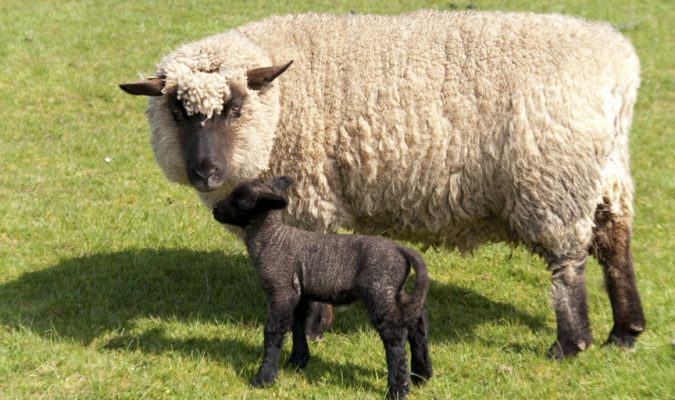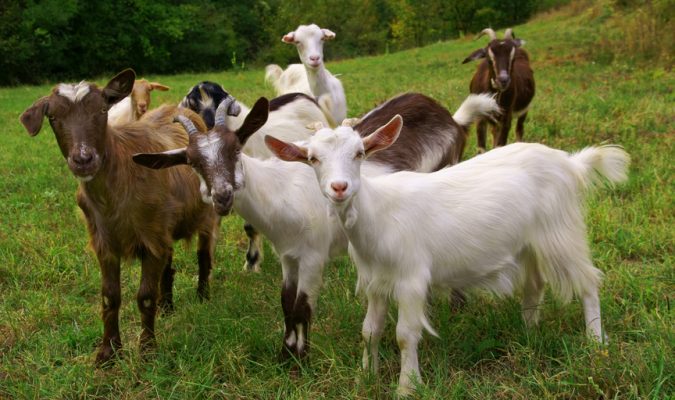In the southeastern region of the United States, small ruminants are at risk for intestinal parasite infestations most of the year, but the season with the greatest risk is spring. So, with the rise in temperatures and the bloom of forage indicating that spring is here, it is also an indication that the intestinal parasites are on the rise. With that in mind, we wanted to provide our small ruminant owners with reliable resources to be able to identify affected animals early, provide the best treatment, and avoid parasite resistance development in your herd.
Both the temperature and moisture content of the environment are ideal for the barber pole worm (Haemonchus contortus) to reproduce. This is the most devastating intestinal parasite that afflicts small ruminants in our region. The barber pole worm thrives in warm and moist environments, making this time of the year the worst for small ruminants. After the parasite is ingested, it makes its way to the “true” stomach (abomasum) of the sheep or goat, where it embeds into the wall of the stomach. There it sucks the blood of the host, leading to anemia and low protein in the blood. Animals with a heavy barber pole worm infestation can have thin condition, pale mucous membranes, scours, weakness, and bottle jaw. The majority of this newsletter will focus on the barber pole worm as it is the main contributor to clinical parasitism, different treatment strategies, and resistance development. So, with the rise in temperatures and the bloom of forage indicating that spring is here, it is also an indication that the intestinal parasites are on the rise. With that in mind, we wanted to provide our small ruminant owners with reliable resources to be able to identify affected animals early, provide the best treatment, and avoid parasite resistance development in your herd.
How To Recognize Parasites In Your Small Ruminants
Clinical Signs of Parasite Infestation: Sheep and goats are prey species, and so they tend to hide any illness or disease. This evolutionary mechanism allows them to avoid being targeted by predators, but it also makes it harder for us to identify the animals that are sick. So, below are some clinical signs for you to look for in your herd to help identify those animals early and maximize treatment success.
- Weight Loss: In the gastrointestinal tract of the host body, parasites rob the nutrients that could go to the host and drain the host’s blood and protein inhibiting the body from utilizing nutrients. So animals with a high load of parasites will typically be thinner compared to the rest of the herd.
- Body Condition Scoring: A way to monitor weight in your small ruminants is to do body condition scoring in your herd. Small ruminants are on a scale of 1-5, where 3/5 is an ideal weight. To do this, you must put your hands on your animals to check for fat coverage. You should not be able to easily palpate your sheep/goats backbone or ribs. Below is a website that illustrates how to body condition score your sheep and goats.
- Diarrhea/Scours: As the parasites in the gastrointestinal tract disrupt the intestinal wall and shed eggs, the host body will experience inflammation in the gut and diarrhea. So, heavily parasitized animals will typically have fecal staining on their tail head and around their rectum indicating loose to watery stool.
- Dull/Unthrifty Coat: Chronic parasitism and a lack of adequate nutrition often leads to these animals lacking a sheen to their coat along with a roughening in its appearance.
- Weakness/Lethargy: With a drain on the nutrition of the host along with a concurrent anemia, these animals will lay around more and be slower to come to feed compared to the rest of the herd.
- Anemia: As stated earlier, the Haemonchus contortus worm sucks the blood of the host in order to reproduce and make more offspring. So, by looking at the mucous membrane color around the eyes and gums we can get a rough idea of the level of anemia affecting that animal.
- Fast Breathing Rate: In parasitized animals you may notice a sustained increase in their breathing rate possibly indicating pain, lung damage, and/or anemia. For reference, the normal respiratory rate of a goat and sheep is around 20-30 breaths per minute.
- Bottle Jaw: As the barber pole worm sucks the blood of the host, level of protein in the vasculature decreases. The protein portion of the blood helps keep the fluid component of the blood within the vessels, and as that decreases fluid will collect in low areas of the body such as below the jaw.
- Coughing: If your goat or sheep is coughing a lot without the accompaniment of a fever or mucous nasal discharge, then you could be dealing with different respiratory parasites that can afflict small ruminants.
Treatment And Prevention Of Parasites
- Strategic Dewormer Use: To help slow the development of parasite resistance in small ruminants, it’s recommended to not blanket deworm your entire herd on a schedule. Rather, you should identify the animals in your herd most affected by parasites through the tactics listed below, and only treat those animals instead of the entire herd.
- FAMACHA®: This is a 1-5 scale scoring system developed to rank the level of parasite load based on how pale the animal’s mucous membranes are at that time. Animals with a score of 4/5 to 5/5 should be dewormed, while animals with a score of 1/5 to 2/5 do not need dewormed, and animals with a score of 3/5 should be dewormed based on their current condition and life stage. It’s recommended to FAMACHA score your herd at minimum every month throughout the year to identify affected animals as early as possible.
- Five Point Check®: This is a method of assessing an animal’s parasite load by looking at the eye mucous membrane color, body condition score, tail fecal staining, nasal discharge, and bottle jaw.
- Fecals: A good way to identify the high parasite shedding animals in your herd is through performing either individual or pooled (~10 herd members) fecal testing on your herd. The fecals will identify the animals shedding the most parasites on your pasture, and this can help to find animals who may need dewormed. If you have an animal that routinely tests high for shedding lots of parasite eggs, then it may be best to cull that animal from the herd. This is because it not only puts the other animals at a higher risk due to increase parasite exposure, but that animal’s offspring may also have the same weak genetics when it comes to parasite immunity.
- Proper Dose: When treating small ruminants using a dewormer, be sure to dose your livestock appropriately. This can be done by using a flexible measuring tape to find the distance around the chest (heart girth) and the length of the animal in inches. The chest is measured by taking the measuring tape around the animal’s chest just behind the elbow and shoulder blades. The length of the animal is done by measuring from the point of the shoulder to the pinbone of the hip by the tail head. The equation to use is (heart girth x heart girth x body length) divided by 300 equals the weight in pounds. Below are links that explain how to do this in more detail.
- Proper Storage of Dewormers: Be sure to follow the label of the drug to help you store your dewormers appropriately to maintain the drug’s effectiveness. So, avoid placing your dewormers in the light and avoid hot or freezing temperatures for storage. It’s typically best to keep them in a cabinet in a building that is temperature controlled to keep the drugs working to their fullest potential.
- Combination Drug Therapy: Some heavily parasitized animals and/or those with a known parasite resistance in their herd may require multiple dewormers from different classes at one time. This allows the drugs to work in synergy to kill off the most amount of worms at one time. This should only be done under the direction of a veterinarian to ensure it’s actually necessary.
- Alternative Therapies: Below are some alternative therapies to reach for when treating and preventing parasites in your herd without needing to rely on dewormers.
- Copper Oxide Wire Particles (COWP): Research indicates that COWP can help control internal parasites such as the barber pole worm. While the mechanism of the product is not fully understood, it’s thought to have direct effects on the worms along with boosting the immune system of the animal. Many heavily parasitized animals also have a weakened immune system, potentially due to a copper deficiency. So, this product can help address both the compromised immune system and the worm load. Just like with the use of dewormers, all animals should have their FAMACHA checked and only give the COWP to the animals that need it based on the FAMACHA scoring system. While the copper can be beneficial to animals that need it, it also has the potential to cause harm if used inappropriately. If given in excess, copper has the ability to cause liver damage and destroy red blood cells, especially in susceptible animals like sheep. Effective dosages of COWP are 0.5 – 1 gram for lambs and kids, then 1-2 grams for adult animals. These doses are based on age and not weight, and repeat dosages can be performed at 6 week intervals if needed.
- Pasture Fungus: There is a product known as BioWorma on the market, and it helps to lessen the parasite burden on your pastures by trapping the fungus within the animal’s own feces. It is a daily feed through product that can be top dressed on feed or incorporated into a mineral mix for your herd. product does nothing for the parasites already on the pasture, because it’s a feed through it only works to kill the larvae that’s within the feces of the animal eating it.
- Bioactive Forages: Some plants contain metabolites that can have direct effects on gastrointestinal worms, helping to decrease the parasitic load. Forages rich in tannins have been shown to have antiparasitic effects on small ruminants. Some of these plants include chicory, pine bark, black locust, tropical legumes, and Sericea lespedeza.
Avoiding Parasite Resistance
- Pasture Management:
- Refugia: This is a concept developed to help slow/prevent parasite resistance development in livestock. It involves only deworming the animals that are clinically affected by parasites based on fecals, FAMACHA, and the Five Point Check. While all small ruminants have some level of parasites at any given time, along with the fact that you will never be able to get rid of parasites entirely. This means we have to keep some level of parasites present on the operation, and therefore we want to keep the weakest parasites possible. So, if an animal that is not currently affected by the parasites based on the Five Point Check, then we know that its parasites are weak and unable to harm that animal. So, we don’t want to deworm that animal because we want to allow those weak parasites to continue to reproduce. This is to help dilute out the genetics of the resistant worms on your operation with the weak worms to help slow resistance development and lessen the need for dewormers.
- Pasture Rotation: Another method to decrease parasite exposure for your herd is through rotating pastures. Due to the lifecycle of the barber pole worm, the egg is not infective until 6 days after being passed in the feces. So, by rotating your pastures every 5 days you can lessen the exposure to the infective barber pole larvae. This not only decreases the chance of overgrazing each pasture, but it also lessens the chance of parasite exposure due to the increased height of the grass. Because parasite eggs develop on the ground in the feces, they then have to climb up the grass to be ingested by the sheep or goat to continue the lifecycle. So, by increasing the grass height we can decrease the parasite exposure to your herd. It’s recommended to not let the grass get shorter than 4 inches off the ground, and it’s preferred for the grass to be 6+ inches off the ground to avoid parasite exposure.
- Multi-species Grazing: Since horses and cattle do not share parasites with sheep and goats, these animals can be either housed together or part of a pasture rotation program to help decrease the pasture worm load. Horses and cattle help through ingesting the worms that can harm small ruminants, because those worms die in the digestive tract of those larger species.
- Dry Lot: Another method to help decrease the parasite burden in your herd is to house your animals on a dry lot. This helps expose the parasite eggs to hot and dry conditions especially in the summer time. Parasite eggs prefer shaded and moist conditions, so by implementing a dry lot the larva are killed quicker due to increased sun exposure, heat, and desiccation.
- Increased Browsing: As mentioned earlier, by allowing goats to eat forage that is 6+ inches off the ground, we can dramatically reduce their parasite exposure. Goats are technically browsers, and so by allowing them to eat shrubs and saplings (as long as the plants are not toxic) as part of a rotational grazing system we can drastically reduce their parasite exposure.
- Improve Sanitation: When feeding your goats grain and or hay it is best to do so off the ground. This can be done through a simple hay net or a more elaborate wooden construction. This decreases the chance of ingesting manure and therefore lessens parasite exposure. It’s also good to prevent the sheep and goats from being able to climb onto where the hay is stored to prevent them from defecating on hay and inoculating it with parasites. Also, any time you can remove the feces from a paddock you immediately remove the source of continued parasite exposure that’s present within the feces.
- Allow Environment to Dry Out: As stated earlier, the parasite eggs do not like the sun, excessive heat, or dryness. So, any method to keep their environment dry is advised. This can include fencing off moist lowland areas and repairing leaking water troughs.
- Decrease Population Density: The more animals on a pasture means the more feces and parasite larvae on the pasture, along with more animals to then ingest those parasites. It’s recommended to not stock more than 2 average sized (Boer-type) goats per acre. Regardless of the recommendation, we need to match the stocking rate of the pasture to the size of the pasture, amount of forage available, and how long animals are allowed to graze a particular pasture. This not only decreases parasite exposure, but it also improves the forage available on the pasture because the animals can’t overgraze it.
- Best Feeding Strategies: When small ruminants are fed appropriately to meet their minimum nutritional requirements especially when it comes to protein, those animals have stronger resiliency to parasites. So, if your herd has a higher worm burden then look to incorporate more protein into the diet either through grain supplementation, legumes, and increasing forage available in a vegetative state.
- Select For Parasite Resistant Animals: It’s recommended to only keep the most productive and parasite resistant animals in your herd, and to cull the animals that require repeat deworming or have consistently high fecal egg counts (FEC). Fecals are the best way to help select for parasite resistance, and it’s recommended to only use bucks/rams with proven parasite resistance for breeding.
I hope the information and resources provided in this newsletter will help you recognize parasites in your herd early to have the best success while still being conscious of parasite resistance. While the barber pole worm was the major focus of this newsletter, there are of course numerous other parasites that can affect small ruminants. So, if you ever have any questions regarding parasites in your herd, how to know which animals are affected, and which drugs to use please give us a call at the office. We can help you prevent parasite infestations in your herd as much as possible to avoid the unfortunate loss of any animals.
Written By: Dr. Gunner Edgell
Rocky River Large Animal Veterinary Clinic is here to serve you and your animals.

